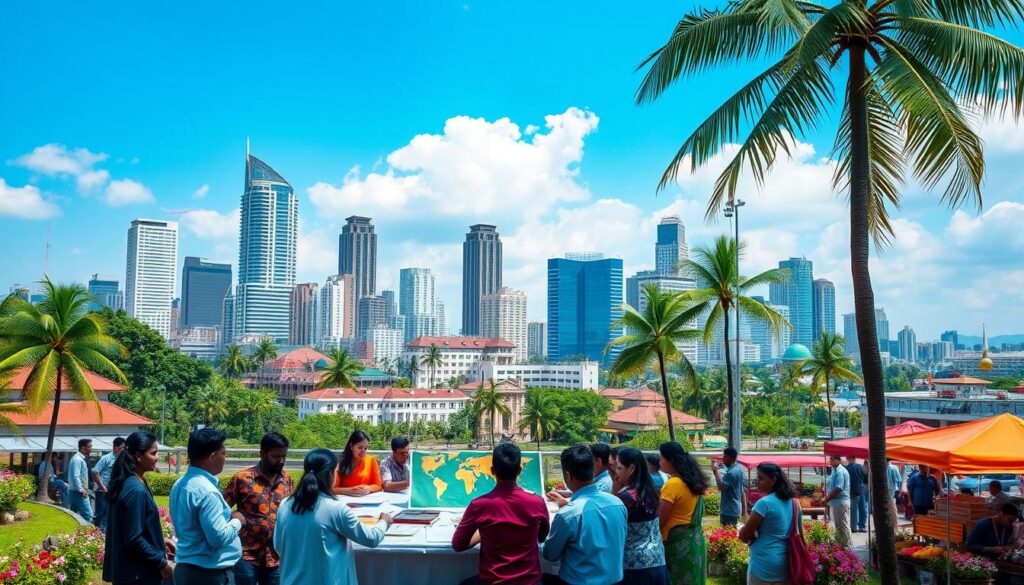Sri Lanka’s New President to Restart Talks with IMF
Sri Lanka faces its worst financial trouble since it became independent in 1948. Its new leaders are acting to fix this major issue. They aim to bring the economy back and follow better money rules.

Sri Lanka is dealing with tough times, with prices rising by 70%. The talks with the IMF could give Sri Lanka up to $3 billion. This money is crucial for recovering from the pandemic and lost money.
These talks are a new start for Sri Lanka, filled with hope. The plan focuses on selling more abroad and owing less money. This strategy fits with Wickremesinghe’s efforts to boost the country’s exports while money reserves are low.
The country is trying to fix a lot of economic problems. Sri Lanka’s new president is bringing back talks with the IMF. Their plan could make Sri Lanka strong and successful by 2048.
Sri Lanka is entering a new phase focusing on economic growth. They are rethinking a huge part of their $29 billion debt with the IMF’s help. This assistance is key to fixing important parts of the country.
The government knows that help from the IMF is just the beginning. Support from countries like Japan will also be necessary. They owe a lot of money to different places, including China, which makes recovery complex.
For more details on President Wickremesinghe’s role, check out this link. The upcoming IMF talks are very important. They’re a chance for Sri Lanka to rise up from its tough situation.
Anura Kumara Dissanayake Assumes Presidency Amidst Financial Turmoil
Anura Kumara Dissanayake has become the President of Sri Lanka at a critical time. He is facing the Sri Lanka economic crisis. His leadership is key to making decisions that will help the nation stabilize.
Dissanayake won 42% of the vote, improving from 3% in the last election. He promised to change how Sri Lanka works with the IMF. This promise, aimed at easing economic pain, has marked a major change in Sri Lanka government policies.
The Path to Presidency: Election Victory in Economic Hardship
Anura Kumara Dissanayake’s presidency reflects the people’s call for change. He got 1.2 million more votes than the runner-up. His campaign focused on economic reform to help those suffering from high prices and shortages.
Sri Lanka’s Bankruptcy and Suspension of Debt Repayments
In 2022, Sri Lanka went bankrupt, showing how severe the Sri Lanka economic crisis was. Not paying debts on $83 billion stopped the economy. This situation called for urgent help and changes in the economy.
Dissanayake must tackle these huge financial problems. This includes talks on tax and revenue targets with others. His goal is to make austerity measures easier for the poor, following new Sri Lanka government policies.
Political Legacy and Crisis: The Fall of Gotabaya Rajapaksa
The economic crisis led to Gotabaya Rajapaksa’s regime falling. This made way for Dissanayake’s leadership. People wanted a leader who could deal with the economic issues, leading to Dissanayake’s victory.
Knowing Anura Kumara Dissanayake‘s economic strategy is crucial. It includes both short-term policy changes and long-term solutions. Examples are the domestic debt restructuring plan. These plans aim to meet IMF requirements and promote growth.
Sri Lanka news updates are keeping an eye on Dissanayake’s actions. His presidency is seen as a chance to stabilize and grow the economy.
IMF Negotiations: A Balancing Act for Economic Recovery
In tackling the Sri Lanka financial crisis, President Anura Kumara Dissanayake faces a tough challenge. He aims to guide Sri Lanka’s IMF negotiations to success. The nation’s foreign debt exceeds $51 billion, with urgent need for smart talks to meet Sri Lanka’s economic recovery goals.
President Dissanayake’s team plans to boost government income to about 15% of GDP by 2025 from 8.2%. They also want to reduce public sector debt to below 100% of GDP. This is a cut from 110% in 2021. Such steps are crucial to move away from the crisis.
Sri Lanka is dealing with big shortages of fuel, medicine, and cooking gas. The World Bank is helping to fix these. The economy shrank by 7.8% in 2022, making it critical to get a $3 billion bailout from the IMF. India has become a key supporter, offering around $4 billion in help.
The rules of the IMF deal are tough, focusing on strict monetary and fiscal goals. President Dissanayake has little space to argue but knows the third review is key for more support. His aim? To manage inflation better.
Raising the value-added tax to 15% and planning a 25-year economic policy show Dissanayake’s tough decisions. Yet, with schools and universities opening again, there’s a hint of normal life returning. IMF negotiations are hard, pushing Sri Lankan leaders to their limits. They must deal with debts, austerity, and keep hope alive for nearly 26% of people living in poverty. It’s a hard path but fighting for political stability, economic fixes, and global support is essential for recovery.
FAQ
Who is the new president of Sri Lanka set to restart IMF negotiations?
Anura Kumara Dissanayake has taken over as Sri Lanka’s president. He’s ready to talk with the International Monetary Fund (IMF). This is to help solve the country’s financial troubles.
What was the situation in Sri Lanka that led to IMF involvement?
In 2022, Sri Lanka could not pay its debts and stopped its debt repayments. This made it necessary for the IMF to step in. Their help is needed for Sri Lanka to improve its economy.
How did Anura Kumara Dissanayake become the president?
Anura Kumara Dissanayake was elected president after he got a lot of public support. He promised to change the tough IMF bailout terms. He also wanted to fix the nation’s “corrupt political culture.”
What are some challenges that the new president faces with the IMF?
President Anura Kumara Dissanayake has to work out a deal with the IMF. He needs to get easier conditions for Sri Lanka. At the same time, he must stick to the strict rules the IMF has set, like keeping certain fiscal targets.
Will there be changes to Sri Lanka’s governmental structure under the new president?
After winning the election, President Dissanayake ended the parliament’s term early and called for new elections. This move suggests there might be changes in how the government works. He’s focusing on fixing the economic and political issues.
What was the role of the previous president, Ranil Wickremesinghe, in the economic crisis?
The last government, led by Ranil Wickremesinghe, raised taxes and reduced spending. This improved the economy a bit and stopped shortages. But it also made life hard for many people. These actions played a part in the country’s financial woes. This led to a need for new leadership.
Has the International Monetary Fund reacted to the potential renegotiation of the bailout terms?
The IMF is open to working with President Dissanayake’s team. They stressed the importance of reviewing the support program. However, experts think that there’s little room for Dissanayake to make big changes to the IMF’s conditions.
How did Sri Lanka find itself in an economic crisis?
Several things caused Sri Lanka’s financial crisis. High foreign debt, political problems, and the COVID-19 pandemic hurt its tourism. This led to a payments crisis and bankruptcy.
What are some of the key policies from Anura Kumara Dissanayake’s platform?
Anura Kumara Dissanayake wants to soften the IMF’s tough bailout rules. He aims to fight political corruption and ensure a fairer economic recovery. This approach is meant to help everyone in Sri Lanka.





